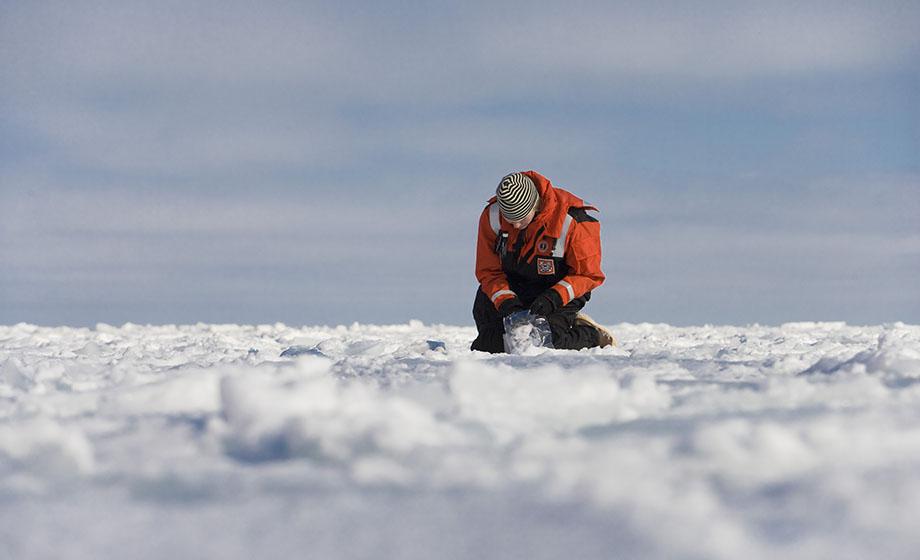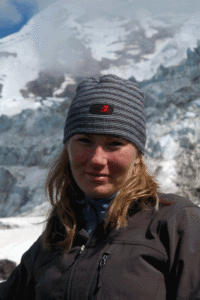
Karen E. Frey, associate professor in the Clark University Graduate School of Geography and research associate professor in the George Perkins Marsh Institute, has been appointed by the National Academy of Sciences to serve on the Marine Working Group of the International Arctic Science Committee (IASC). Only two U.S. scientists were appointed to this prestigious group; Frey will serve at least one four-year term.

Chukchi and Beaufort seas.
The IASC is a non-governmental, international scientific organization that encourages and facilitates collaboration on Arctic research. The IASC has five working groups (Atmosphere, Cryosphere, Marine, Social and Human, and Terrestrial); the United States can appoint up to two scientists to serve in each working group, with two additional delegates serving as team leaders. A complete list of appointees can be found online.
Members of the Marine Working Group are internationally recognized experts who predict and follow rapid changes to the ocean system, enhance and improve access to the paleo record of the Arctic Ocean through scientific drilling, understand biological and ecosystem processes in the Arctic and sub-Arctic seas, and focus on sea ice structure dynamics.
“As research questions in the Arctic sciences are inherently interdisciplinary, scientifically complex, require logistically difficult field operations and oftentimes have an international scope, committees such as IASC are incredibly important for facilitating collaboration among researchers in this field,” Frey said. “I’m thrilled to have been appointed to serve with such an impressive group of Arctic scientists.”
Frey will attend her first meeting of the working group at The Arctic Science Summit Week (ASSW) in Prague, the Czech Republic, March 31 through April 7.
Frey, who joined the Clark faculty in 2007, has conducted field-based research in West and East Siberia, as well as in the Bering, Chukchi and Beaufort seas. She is currently the major research adviser for seven students at Clark who are working on projects in Alaska, West Greenland and the Arctic seas. She is a member of several professional organizations, including the American Association for the Advancement of Science, the American Geophysical Union, the Association of American Geographers, the Geological Society of America and the Society of Woman Geographers.
Throughout her career, Frey has received grants totaling more than $13 million. Her most recent work with researchers at the University of Washington, the National Aeronautics and Space Administration (NASA) and the U.S. Army Cold Regions Research and Engineering Laboratory received a grant from NASA for a project titled “Observing and Understanding the Impacts of a Thinning and Retreating Sea Ice Cover on Light Propagation, Primary Productivity and Biogeochemistry in the Pacific Arctic Region.” The Clark portion of the grant exceeded $600,000 over a three-year period.
Recently, Frey’s research into thinning sea ice was cited in an article published in the American Association for the Advancement of Science’s Science Advances. In the summers of 2010 and 2011, Frey and her colleagues discovered huge, “pea-soup” swathes of highly productive phytoplankton blooms above Arctic Ocean continental shelves below the pack ice in the Chukchi Sea.
“Phytoplankton are the base of the entire marine food chain and are critically dependent on the availability of nutrients and light,” Frey noted in 2012. “We found a surprisingly large amount of light that is transmitted through the sea-ice cover, particularly through the turquoise-blue melt ponds that dot the bare-white ice cover. Our findings lead to important questions as we consider the impact of climate warming on the physical properties of sea ice, which have critical consequences for the entire Arctic marine ecosystem.”
Now researchers have announced that algae blooms are occurring even more frequently.
“Our model results indicate that the recent thinning of Arctic sea ice is the main cause of a marked increase in the prevalence of light conditions conducive to sub-ice blooms,” the researchers reported in Science Advances. “We find that as little as 20 years ago, the conditions required for sub-ice blooms may have been uncommon, but their frequency has increased to the point that nearly 30 percent of the ice-covered Arctic Ocean in July permits sub-ice blooms. Recent climate change may have markedly altered the ecology of the Arctic Ocean.”


